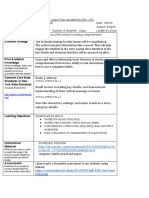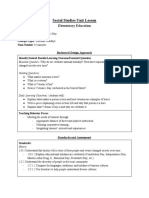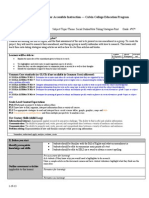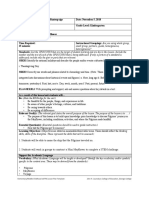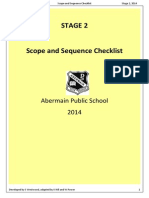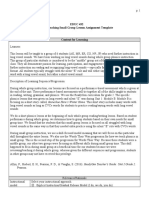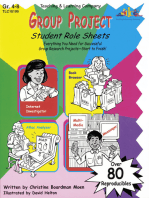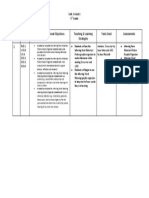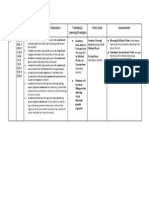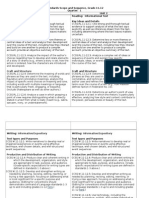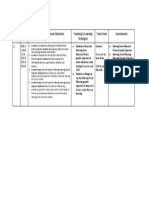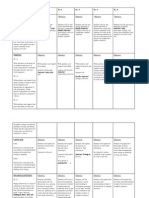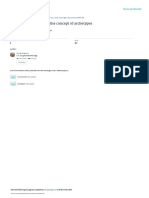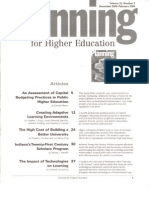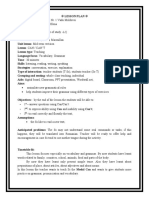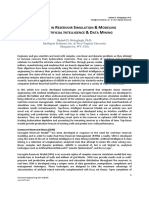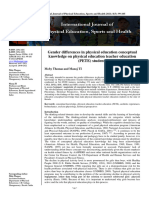2nd Grade Unit Plan
2nd Grade Unit Plan
Uploaded by
api-259785027Copyright:
Available Formats
2nd Grade Unit Plan
2nd Grade Unit Plan
Uploaded by
api-259785027Original Title
Copyright
Available Formats
Share this document
Did you find this document useful?
Is this content inappropriate?
Copyright:
Available Formats
2nd Grade Unit Plan
2nd Grade Unit Plan
Uploaded by
api-259785027Copyright:
Available Formats
2nd Grade Unit Plan
Quarter 1: Unit 1
Grade Level:
Unit Name:
Unit Overview:
Duration:
Second Grade
Learning Life Lessons Through Literature
This unit was designed to develop students understanding of how literature comes from
diverse cultures and teaches moral lesson that can be used to solve problems in society
today. During the duration of this unit students will actively engage in reading, writing,
speaking, and listening activities that will lead to daily reading practices that shall
enhance comprehension of grade level text. This unit focuses on narrative text types
and text structure. Daily instruction will emphasize a range of text types representative
of many diverse cultures. Students will be immersed in the use of academic language
that exhibits their understanding of literacy concepts.
5 weeks
Enduring
Understandings
Effective readers understand that by using various literary strategies and
reading strategies they can better comprehend the text.
Effective readers understand that stories are from a broad range of diverse
cultures, are told through written and oral expression, and have a central
message.
Effective listeners and speakers understand that by collaborating with diverse
partners about topic or text, they can share key details, gather additional
information, get clarification, and get a deeper understanding of topics or texts
under discussion
Effective writers understand that narratives recount an event or series of
events and are developed through a process
Effective speakers and writers understand that Standard English conventions
related to grammar, capitalization, punctuation, and word meaning must be used
when writing and speaking.
Essential
Questions
What literary and reading strategies do effective readers use while reading
literature?
Why do effective listeners and speakers collaborate with diverse partners
about 2nd grade topics and texts?
Why do writers write narratives?
What process do effective writers use when writing a narrative?
Common Core
Standards
Primary Standards (these standards are taught and assessed)
RL 2.1 RL 2.2 RL 2.3 RL.2.4 RL 2.7 W. 2.3
Secondary Addressed (these standards are taught-not assessed)
W.2.5, SL 2.1, SL.2.2, SL 2.4 SL.2.3, SL 2.5 ,SL 2.6 , L.2.1, L.2.2, L.2.3. ,L 2.5 ,
1
2nd Grade Unit Plan
Quarter 1: Unit 1
Unit One
Standards at a Glance
Strands Week 1 Week 2 Week 3 Week 4 Week 5
Reading for
Literature
2.RL.1,
2.RL.7
2.RL.2,
2.RL.3
2.RL.3,
2.RL.4
2.RL.4,
2.RL.7
2.RL.1, 2.RL.2,
2.RL.3, 2.RL.4,
2.RL.7 (Assess)
Writing 2.W.3,
2.W.5
2.W.3,
2.W.5
2.W.3,
2.W.5
2.W.3,
2.W.5
2.W.3, 2.W.5
(Assess)
Language 2.L.1 2.L.1, 2.L.2, 2.L.2, 2.L.2 2.L.2, 2.L.2 2.L.1, 2.L.2
Speaking and
Listening
2.SL.1,
2.SL.6
2.SL.3,
2.SL.6
2.SL.2,
2.SL.6
2.SL.5,
2.SL.6
2.SL.4, 2.SL.6
Content:
Learning
Objectives
Unit One
Learning Objectives at a Glance
Strands Week 1 Week 2 Week 3 Week 4 Week 5
Reading RL 2.1, 2.7
Ask/Answer questions
using who, what, where,
and when to
demonstrate
understanding of key
details in text.
Use information from
illustrations to
determine character,
setting, and plot.
Use words in print to
determine character,
setting, and plot.
RL 2.1, 2.2,
2.3
Ask/Answer
questions using
who, what, where,
and when to
demonstrate
understanding of
key details in
text.
Recount stories
Describe how
characters
respond to major
events and
challenges
RL 2.1, 2.3,
2.4
Ask/Answer
questions using
who, what, where,
and when to
demonstrate
understanding of
key details in
text.
Describe how
words and
phrases supply
rhythm/meaning
.
Describe how
characters
respond to major
events and
challenges
RL 2.1 ,2.2
2.3
Ask/Answer
questions using
who, what, where,
and when to
demonstrate
understanding of
key details in
text.
Determine
central message,
lesson, or moral.
Describe how
characters
respond to major
events and
challenges
RL2.1, 2.2,
2.3
Ask/Answer
questions using
who, what, where,
and when to
demonstrate
understanding of
key details in
text.
Recount stories
Describe how
characters
respond to major
events and
challenges
Writing W 2.3, 2.5
Recount two or more
appropriately sequenced
events.
W 2.3, 2.5
Recount two or
more
appropriately
sequenced
events.
Include details
to describe
actions.
W 2.3, 2.5
Include details
to describe
thoughts
Include details
to describe
feelings.
W. 2.3, 2.5
Use temporal
words to signal
event order
Provide a sense
of closure
W 2.3, 2.5
With guidance
and support from
adults and peers,
focus on a topic
and strengthen
writing as
needed by
revising and
editing
Speaking
&
Listening
SL 2.1, 2.6
Follow agreed-upon rules
for discussions and
describe details from an
experience or text
SL 2.3, 2.6
Ask and answer
questions about
what a speaker
says
SL 2.2, 2.6
Describe events
using details in
complete
sentences
SL 2.5, 2.6
Create
recordings of
sequenced
stories, add
illustrations
SL 2.4,2.6
Describe a story
or event through
oral expression,
speaking in
clear, complete
sentences
2
2nd Grade Unit Plan
Quarter 1: Unit 1
Language L 2.1
Use standard English
grammar and usage when
writing or speaking
L 2.1, 2.2
Use standard
english grammar
and usage when
listening/
speaking and
conventions
L 2.1, 2.2
Use standard
english grammar
and usage when
listening/
speaking and
conventions
L 2.1, 2.2
Use standard
english grammar
and usage when
listening/
speaking and
conventions
L 2.1, 2.2
Use standard
english grammar
and usage when
listening/
speaking and
conventions
Cognitive Skills
( suggested
mini-lessons)
-Make and verify predictions
-Identify/understand key ideas
-Infer answers from details and background information
-Identify fact and opinion
-Identify relevant and irrelevant details
-Use personal experience to support answers
-Identify authors purpose
-Identify dialogue
-Identify narrator
-Identify point of view
-Recount the story events in sequential order
-Identify literature text types
-Make text-to-text, text-to-self, text-to-world connections
-Make comparisons between text types
-Identify/interpret figurative language
-Describe character, traits, and motivations
-Compare & contrast characters
-Use text evidence to support oral and written responses
-Use illustrations to describe the text
-Determine key details from print/ digital text matched with illustrations
-Identify reality and fantasy
Assessments
(D) Diagnostic
(F) Formative
(S) Summative
Mentor Text
Chrysanthemum
Elberts Bad
Diagnostic Assessment RL 2.2, W 2.3, SL 2.4
Students will listen to or read the story Chrysanthemum. He/she will tell about a time
when he/she was teased or witnessed someone else being teased. He/she will tell what
happened before and after the teasing took place. He/she will tell what lesson was
learned from the experience.
Task 1
With a partner, students will recount a story about a real life teasing experience.
Task 2
Students will complete a graphic organizer recounting the sequence of events in their
personal story.
Task 3
Students will write a short story describing their own personal experience and identify
the lesson learned from their experience.
Formative Assessments
1. Reading/Writing conferences
2. Self/Peer Assessments
3. Post-it notes or annotations
4. Short-answer responses
5. Exit slips or three minute writes
6. Turn and talk or Think, Pair, and share
7. Readers/Writer's notebook assignments
8. Observations
3
2nd Grade Unit Plan
Quarter 1: Unit 1
9. Graphic organizers
10. Oral Questioning
Summative
Performance Assessment RL 2.2, W 2.3, SL 2.4
Just like the character Elbert in the story, Elberts Bad Word, think about a time when
you accidentally made a bad decision. Tell what happened before and after you made
the bad decision. Explain what lesson you learned from the experience. Write a
narrative about the event-identify the lesson that you learned from the experience.
Be sure to include the following in your writing:
Detail sentences telling about the bad decision you made
Detail sentences that explain what happened before and after you made the bad
decision
Use time order words (temporal words) to show event order
Detail sentences telling what lesson you learned from the experience
A statement that gives the writing closure
Task 1
Make a list of times that you did something that you werent suppose to-you made a bad
decision. Choose one event to write a narrative about.
Task 2
With a partner, recount the events of your story in the order that they happened. Use a
graphic organizer to tell the events that happened before and after you made the bad
decision
Task 3
Tell how you felt before and after you made the bad decision and what lesson you
learned
Task 4
Write a narrative, recounting a well elaborated event, using details sentences, temporal
words, and providing a sense of closure.
Suggested
Book List
( read alouds,
shared
readings,
guided
readings,
independent
readings)
We Are Best Friends The Boy Who Cried Wolf
Little Red Riding Hood Cinderella
Chicken Little Rumpelstiltskin
Lon Po Po Peters Chair
Jamaicas Find Helen Keller
Ruby Bridges Wilma Rudolph
Little Bill Series
Brundibar Mr. Peabodys Apples
Sam and the Lucky Money How to Lose All Your Friends
Leo the Late Bloomer Whoever You Are
Earrings Stone Soup
Five Chinese Brothers Greedy Anansi
Anansi and the Turtle Ant and the Grasshopper
Lion and the Mouse The Tortoise and the Hare
Suggested
Resources
Poems, Passages and Leveled Text
www.isbe.net
www.readinga-z.com (Leveled text, passages, reading graphic organizers)
www.readworks.org (graphic organizers, reading passages)
hil.troy.k12.mi.us/staff/bnewingham/.../Reader's%20Notebooks.htm (readers
notebook/journal resources)
4
2nd Grade Unit Plan
Quarter 1: Unit 1
http://www.teachingideas.co.uk/english/files/storyplans.pdf. (resources for genres of
writing)
http://www.ttms.org/ (reading and writing curricular resources)
http://www.sfps.info/documentcenter/view/7273 (Asking and Answering Questions
Teaching Resources)
Reading Workshop anchor charts
Writing Workshop anchor charts
Classroom Word Wall
Classroom Library
Key Vocabulary key details, question, describe, who, what, where, when, why, how, recount, fable,
folktale, culture, central message, lesson, moral, major event, describe, character,
recount, plot, conclusion, problem, solution, conflict, text, text evidence, simile,
metaphor, idiom, point-of-view, narrator, dialogue, authors purpose, predictions,
illustration, setting
Learning
Activities
Description of Instructional Delivery Methods for Unit One
For the first unit of instruction the teacher and students will work on establishing
routines and practices that will be used all year long to develop effective readers and
writers. Through the Balanced Literacy Approach or Workshop Model Approach to
teaching an integrated unit, with the teacher following the Gradual Release of
Responsibility Model for Instructional Delivery ( I do, We do, You do it together,You
do it alone) students will be immersed in read alouds, shared readings, guided
readings, and independent readings. They will also engage in guided writings, shared
writings, interactive writings, and independent writings. Through the use of
mini-lessons and conferring, the teacher will model/scaffold reading, literary, and
annotation strategies to teach students how to monitor their own comprehension.
Teacher will model and prepare students for partnership discussions to practice sharing
what they are learning about reading, what they enjoy about books, and how they grow
as readers. Students will participate in ( small group) collaborative conversations
where they will have text-based discussions and/or debates to help support one
anothers learning.
Week 1- Preparing Students for Reading and Writing
During the first week of school the teacher and students will develop class reading
goal(s) for the first five weeks. Post the reading goal(s) in the classroom. The goal
setting process should be repeated every five weeks. Students will create readers
notebooks or readers journal. Teacher will disseminate reference sheets that students
will paste down in their readers/writers notebook. These reference sheets are
necessary for active reading engagement throughout the year. (suggested reference
materials website) hil.troy.k12.mi.us/staff/bnewingham/.../Reader's%20Notebooks.htm
The teacher will began the introduction to the Gradual Release of Responsibility during
week one. The teacher will model fluent reading by reading aloud any book from the
suggested book list to the students several days of the first week of school. The
teacher and students will discuss the listening expectations for the students. The
teacher will explain to students that over the course of the unit they will be reading
many different stories with a positive central message. These stories represent one
purpose for reading-to teach a lesson. While conducting a read aloud/think aloud the
teacher will model a mini-lesson on questioning. The teacher will engage the students in
shared readings using any book or excerpt, from the suggested book list. The teacher
and students will determine guidelines for partner and/or collaborative conversations
and the teacher will lead the students in a text-based discussion. With guidance from
5
2nd Grade Unit Plan
Quarter 1: Unit 1
the teacher the students will engage independently in text-dependent activities that
require them to ask and answer WH questions about the text, and also use illustrations
to identify information about the characters, settings, and plot. The writing strategy
will focus on prewriting and drafting. Students will practice the skill of recounting two
or more appropriately sequenced events. The Language focus will be to identify a
sentence. By the end of the week, students should be assessed on asking and answering
questions and story sequence.
Week 2- Reading Complex Text and Narrative Writing
Teacher should review standards previously taught and introduce new standards so that
students understand the purpose. Provide several reasons why their new learning is
relevant for them (e.g to become a better reader, expand their vocabulary, etc.)
Throughout the week, students will practice the skills of asking and answering WH
questions, recounting stories and describing a characters action and reactions.
Teach a mini-lesson on identifying the plot( 2 days) and characterization ( 2 days).
In small guided reading groups (if applicable) the teacher should work to reinforce the
daily reading skill while using differentiated materials. During independent work, the
students should work using the same reading skill using differentiated or grade level
text and/or activities. Engage writers in developing personal narratives. Start with a
mentor text to read aloud, minilesson, shared/guided writing, transition into
independent writing while the teacher confers, students collaborate within groups, and
the class conducts a whole group share session. Teacher models what are the elements
to a narrative during the minilesson. Together students will work cooperatively to
develop their writing. Teacher and students engage in mini-lessons around organizing
their writing during the process (e.g. unfinished work, illustrating, publishing),
brainstorming and prewriting, and planning out their writing using graphic organizers.
To encourage students in speaking and listening, provide a mini lesson on questioning a
speaker. Students should practice asking and answering questions about what a speaker
says. In Language students will learn to identify parts of a sentence,and use correct
capitalization. By end of week, students should be assessed using the sequence of
events chart and character traits flow chart.
Week 3: Reading Complex Text,Writing about Reading, Narrative Writing
During week 3,,using poems and stories, teach mini-lessons around context clues.
Students should practice the skill of describing how words supply rhythm and meaning
from a selected story, poem or song. (see attached resources for suggestions)
In small guided reading groups (if applicable) the teacher should work to reinforce the
daily reading skill while using differentiated materials. During independent work, the
students should work using the same reading skill using differentiated or grade level
text and/or activities. During collaborative discussions students should work together
on the same skill having a tex- based debate or a text-based discussion For example,
students could re-read (partners/small groups) about the books and record (write)
ideas using a graphic organizer and discuss. Students can also record in their journals
daily about what theyre reading or the focus reading strategies and discuss. Students
will continue the narrative process by revising their writing. After teacher presents a
mini lesson on revisions, students should work to include key details and sentences to
describe thoughts and feelings. In Language, students should learn to identify
statements and questions, as well as us correct punctuation. By the end of the week, the
students should be assessed on using context clues in stories and poems.
6
2nd Grade Unit Plan
Quarter 1: Unit 1
Week 4 Reading Complex Texts,Writing about Reading,Narrative Writing
Remind the students that over the course of the unit they have been reading many
different stories with a positive central message. These stories represent one purpose
for reading-to teach a lesson. Through mini-lesson teach the skill of identifying the
central message or moral of a story ( 2 days) and recounting story events (2 days).
Engage readers in using their Readers Notebooks or journals to respond to their
thinking about reading or being read to and allow them to discuss their ideas in a
text-based discussion with their peers. Engage writers in revising through adding
temporal words, writing a closing, fixing up any confusing parts; adding more important
details into the stories. In Language, students should learn to identify exclamations and
commands, as well as use correct punctuation. By the end of the week, students should
be assessed over identifying the central message.
Week 5-Combining What Weve Learned
During the final week of this unit, work collaboratively to combine all of what they have
learned from prior weeks. Teach mini-lessons on identifying a storys plot and
characterization. Students will recount stories, describe a characters actions and
reactions and determine the moral of a story. For speaking and listening, teacher will
model how to retell stories orally and students will practice this skill by describing a
story or event with expression, complete and coherent sentences.
Together students will work collaboratively to improve writing skills and develop their
writing. As their writing develops, sharing and conferring is an on-going integral part
of the process. To focus students writing the big questions that will drive this
instruction are, What makes this good writing? What would make this writing better?
Whats the one most important thing you want your audience to know? Why did you write
this? What does your audience need to know? Teachers should focus writing minilessons
around producing a final draft with illustrations.
7
2nd Grade Unit Plan
Quarter 1: Unit 1
Teacher Points
to Consider
Read Aloud/Think Aloud:
Read aloud should be a separate time in addition to your reading workshop block. The
read aloud block should be 15-30 minutes depending on the age of the students and/or
teaching points. For this unit, it is recommended that read aloud be done prior to the
mini lesson in order to use the read aloud as a teaching point for the mini lesson. You
may need to rearrange your schedule for this to happen. The teacher will want to use
the talk, thinking and fluency strategies.
Word Study:
Word Study can take place during small group instruction. This is an alternative to
traditional spelling instruction. It is based on learning word patterns rather than
memorizing unconnected words.
Book clubs:
Book clubs allow for similar level children to read the same book and have conversations
about the book. Book club selections should lead themselves to varied and deep
connections. With teacher assistance, the students make reading assignments consisting
of pages to read and focus for reading. Then the students read the assignment
independently and prepare for discussion by either writing in their reading journal or
using sticky notes. During book club sessions, it is important for teacher to support the
work of this unit. Students who are primarily working on comprehension should be in
book clubs.
Close Reading:
Close reading teaches students to make meaning of text. Students engage in close
readings around what the text says (retell/summary), how the text is written (word
choice, details in the illustrations, style) and why the text was written (central
idea/purpose/lesson). Teachers model and encourage students to read closely as part of
a read aloud or shared reading instruction.
Guided Reading:
Guided reading instruction is one type of small group instruction driven by students
needs, which are matched to the supports and challenges of a text. Planning for guided
reading includes knowing students strengths and needs to ensure that each student
reads the text successfully. Whenever reading, students use strategic actions that
support their thinking.
Individual Conferences:
Teacher-student conferences enable a teacher to understand each students
reading/writing process. This personalized instruction will help students refine and
extend their reading/writing competencies. Notes taken during both reading and writing
conferences should be used to inform instruction and set goals with students.
8
2nd Grade Unit Plan
Quarter 1: Unit 1
You might also like
- 1 GST 101 - Use of English and Communication Skills I PDFDocument194 pages1 GST 101 - Use of English and Communication Skills I PDFMC McClanahan100% (6)
- 2nd A Bad Case of StripesDocument10 pages2nd A Bad Case of Stripesapi-539198127No ratings yet
- SIOP Lesson PlanDocument16 pagesSIOP Lesson PlanKim GleasonNo ratings yet
- Diary of A Spider Lesson PlanDocument6 pagesDiary of A Spider Lesson Planapi-265534860No ratings yet
- Small Group Lesson PlanDocument24 pagesSmall Group Lesson Planapi-252466047No ratings yet
- Lesson Plan - Kindergarten Math 2Document4 pagesLesson Plan - Kindergarten Math 2api-430079796No ratings yet
- Literacy Lessons Week 7 of Unit Plan Week 2 of PlacmentDocument14 pagesLiteracy Lessons Week 7 of Unit Plan Week 2 of Placmentapi-408277860No ratings yet
- RainbowfishlessonplanDocument5 pagesRainbowfishlessonplanapi-341402633No ratings yet
- Comprehension Strategy Book ListDocument2 pagesComprehension Strategy Book Listakenda267% (3)
- Place Value Whole NumbersDocument32 pagesPlace Value Whole NumbersgnanasekarNo ratings yet
- Earth Unit - Grade 1Document93 pagesEarth Unit - Grade 1Morgan BaydaNo ratings yet
- Edn2104 - Tasks 1-11 Carly Williamson 32468197Document13 pagesEdn2104 - Tasks 1-11 Carly Williamson 32468197api-330742087No ratings yet
- Unit Plan TemplateDocument10 pagesUnit Plan Templateapi-312623909No ratings yet
- The Effects of Using Litearcy Centers in A First Grade Classroom - Laquita CovingtonDocument14 pagesThe Effects of Using Litearcy Centers in A First Grade Classroom - Laquita Covingtonapi-457149143No ratings yet
- Emm209 2 5Document20 pagesEmm209 2 5api-326968990100% (1)
- The Mitten - Communicating and Listening-Lesson 1Document10 pagesThe Mitten - Communicating and Listening-Lesson 1api-273142130No ratings yet
- Literacy Work Stations: Belén Embid CEIP J.A. Labordeta (Zaragoza)Document17 pagesLiteracy Work Stations: Belén Embid CEIP J.A. Labordeta (Zaragoza)labordetainglesNo ratings yet
- Math 3 - Unit 1 - Place Value and Expanded FormDocument38 pagesMath 3 - Unit 1 - Place Value and Expanded FormKathy Runkle100% (1)
- Running Head: School Wide Literacy Plan 1Document10 pagesRunning Head: School Wide Literacy Plan 1api-548263927No ratings yet
- Opinion Writing Lesson 4Document6 pagesOpinion Writing Lesson 4api-599252831No ratings yet
- Grade 1 Language Arts Scope and SequenceDocument44 pagesGrade 1 Language Arts Scope and SequenceSamantha Wilson0% (1)
- Personal Narrative Lesson Plan 5th GradeDocument2 pagesPersonal Narrative Lesson Plan 5th Gradeapi-252519456No ratings yet
- K-3 Lesson Plan Framework: Cake To Answer Comprehension QuestionsDocument5 pagesK-3 Lesson Plan Framework: Cake To Answer Comprehension Questionsapi-278470419No ratings yet
- Kutztown University Elementary Education Department Professional Semester Program Lesson Plan FormatDocument10 pagesKutztown University Elementary Education Department Professional Semester Program Lesson Plan Formatapi-455168725No ratings yet
- Grade 3 Clues and Conclusions Peru Lesson Plan 2 SsDocument5 pagesGrade 3 Clues and Conclusions Peru Lesson Plan 2 Ssapi-264279988No ratings yet
- Read Aloud Lesson PlanDocument6 pagesRead Aloud Lesson Planapi-349922174No ratings yet
- Lesson 2Document4 pagesLesson 2api-325715593No ratings yet
- Third Grade - Creating Mental ImagesDocument8 pagesThird Grade - Creating Mental Imagesapi-527684545No ratings yet
- Bridging: MSMU Lesson Plan FormatDocument7 pagesBridging: MSMU Lesson Plan Formatapi-547294586No ratings yet
- Sight Word Lesson Edr 317Document4 pagesSight Word Lesson Edr 317api-244087794No ratings yet
- DR Seuss Lesson Plan - Alyssa 2016Document3 pagesDR Seuss Lesson Plan - Alyssa 2016api-272228988No ratings yet
- 1st Grade Reading Lesson PlanDocument5 pages1st Grade Reading Lesson Planapi-483325082100% (1)
- Comparing and Contrasting LessonDocument3 pagesComparing and Contrasting Lessonapi-241115908No ratings yet
- Day/Hour 1 Day/Hour 2 Day/Hour 3 Day/Hour 4 Day/Hour 5: CalendarDocument2 pagesDay/Hour 1 Day/Hour 2 Day/Hour 3 Day/Hour 4 Day/Hour 5: CalendarMorganNo ratings yet
- Title of Unit Grade Level 3 Curriculum Area(s) Time Frame 3-4 Weeks Developed byDocument9 pagesTitle of Unit Grade Level 3 Curriculum Area(s) Time Frame 3-4 Weeks Developed byapi-590146884No ratings yet
- Morning MeetingDocument9 pagesMorning Meetingapi-539944028No ratings yet
- Evaluation Mini UnitDocument13 pagesEvaluation Mini Unitapi-2968568830% (1)
- PBL 2Document6 pagesPBL 2api-245618331No ratings yet
- Lesson Plan 2 PhonicsDocument7 pagesLesson Plan 2 Phonicsapi-308967402No ratings yet
- Kindergarten RetellingDocument4 pagesKindergarten Retellingapi-534358409No ratings yet
- Supervisor Obs 1 Lesson Plan - Place Value Small GroupDocument9 pagesSupervisor Obs 1 Lesson Plan - Place Value Small Groupapi-527837589No ratings yet
- Fairy Tale LessonDocument5 pagesFairy Tale Lessondisney4meNo ratings yet
- Social Studies LessonDocument4 pagesSocial Studies Lessonapi-354685236No ratings yet
- TPGP FinalDocument4 pagesTPGP Finalapi-267136890No ratings yet
- Lesson1 NotetakinginprintDocument6 pagesLesson1 Notetakinginprintapi-300099149No ratings yet
- English FPDDocument8 pagesEnglish FPDapi-306743539No ratings yet
- Thanksgiving Lesson 3Document5 pagesThanksgiving Lesson 3api-403670756No ratings yet
- Goldberg Siop Lesson Plan 1Document5 pagesGoldberg Siop Lesson Plan 1api-459351252No ratings yet
- Co-Teaching ReflectionDocument4 pagesCo-Teaching ReflectionBeverlyCortezNo ratings yet
- Wilmu Lesson Plan PhonicsDocument13 pagesWilmu Lesson Plan Phonicsapi-242142698100% (1)
- Lesson Plan-Story Elements-Yasmeen RDocument2 pagesLesson Plan-Story Elements-Yasmeen Rapi-508750657No ratings yet
- S2 English Scope and Sequence ChecklistDocument17 pagesS2 English Scope and Sequence ChecklistS TANCREDNo ratings yet
- Lesson Plans For Week Long Literacy BlockDocument10 pagesLesson Plans For Week Long Literacy Blockapi-3031259470% (1)
- Week 3 Third Grade Digital Learning Lesson PlansDocument4 pagesWeek 3 Third Grade Digital Learning Lesson Plansapi-312354951No ratings yet
- Grade 3 Ss Studying Pictures CC Peru Lesson Plan 4Document4 pagesGrade 3 Ss Studying Pictures CC Peru Lesson Plan 4api-264279988No ratings yet
- Chesters Way Character TraitsDocument3 pagesChesters Way Character Traitsapi-241115908100% (1)
- English 2 AssignemntDocument10 pagesEnglish 2 Assignemntapi-462146812No ratings yet
- Small Group Sample Lesson PlanDocument18 pagesSmall Group Sample Lesson Planapi-539673881No ratings yet
- Grade 2 Literacy Curriculum PDFDocument17 pagesGrade 2 Literacy Curriculum PDFhlariveeNo ratings yet
- Learning in Motion, Grade 1: Teaching Language Arts and Math through MovementFrom EverandLearning in Motion, Grade 1: Teaching Language Arts and Math through MovementNo ratings yet
- Group Project Student Role Sheets: Everything You Need for Successful Group Research Projects . . .From EverandGroup Project Student Role Sheets: Everything You Need for Successful Group Research Projects . . .No ratings yet
- UnitplantemplateDocument8 pagesUnitplantemplateapi-259785027No ratings yet
- Grade 5 Overviewq 3 Unit 5Document3 pagesGrade 5 Overviewq 3 Unit 5api-259785027No ratings yet
- Grade 5 Overviewq 4 Unit 7Document3 pagesGrade 5 Overviewq 4 Unit 7api-259785027No ratings yet
- Grade 1 Unit Doc1updatedDocument6 pagesGrade 1 Unit Doc1updatedapi-259785027No ratings yet
- 5thgrade q2 Unit3Document2 pages5thgrade q2 Unit3api-259785027No ratings yet
- Unit 2 Week 1Document1 pageUnit 2 Week 1api-259785027No ratings yet
- Unit 2 Week 4Document1 pageUnit 2 Week 4api-259785027No ratings yet
- Multiple Main Idea Graphic OrganizerDocument1 pageMultiple Main Idea Graphic Organizerapi-259785027No ratings yet
- Week 3 Unit 1Document1 pageWeek 3 Unit 1api-259785027No ratings yet
- Unit 2 Week 3Document1 pageUnit 2 Week 3api-259785027No ratings yet
- 11-12 Scope and Sequence FinalDocument19 pages11-12 Scope and Sequence Finalapi-259785027No ratings yet
- Unit 2 Week 1Document1 pageUnit 2 Week 1api-259785027No ratings yet
- Week1 Unit1Document2 pagesWeek1 Unit1api-259785027No ratings yet
- Week-4 Unit 1Document2 pagesWeek-4 Unit 1api-259785027No ratings yet
- Finished9-10th Overview FinalDocument2 pagesFinished9-10th Overview Finalapi-259785027No ratings yet
- Hogenson-2019-Journal of Analytical Psychology PDFDocument20 pagesHogenson-2019-Journal of Analytical Psychology PDFCharles MorrisonNo ratings yet
- Semester 1 Final ProjectDocument2 pagesSemester 1 Final ProjectmemeNo ratings yet
- TOEFL Training UlbDocument2 pagesTOEFL Training UlbMaulid MuhammadNo ratings yet
- Detailed Lesson Plan in Eng 2Document6 pagesDetailed Lesson Plan in Eng 2Kharla CuizonNo ratings yet
- CatalanDocument255 pagesCatalanAdam Masters100% (3)
- Creating Adaptive Learning Environments - SCUP JournalDocument13 pagesCreating Adaptive Learning Environments - SCUP JournalJonathan Kendall100% (1)
- Lesson Plan VDocument6 pagesLesson Plan VAdrian AndrasNo ratings yet
- Developing Professional PracticeDocument5 pagesDeveloping Professional PracticeDianne AllenNo ratings yet
- Interview Evaluation ScorecardDocument5 pagesInterview Evaluation Scorecardemmalyne100% (1)
- Advances in Reservoir SimulationDocument6 pagesAdvances in Reservoir SimulationabrahamauduNo ratings yet
- Herzberg's TheoryDocument10 pagesHerzberg's Theoryapi-3765623100% (2)
- Verb Tenses Review ChartDocument1 pageVerb Tenses Review ChartNúria LNo ratings yet
- TOEFL PREP 1 STRUCTURE - 5ad8aa542d8eaDocument96 pagesTOEFL PREP 1 STRUCTURE - 5ad8aa542d8eaYuhaning AudiyaNo ratings yet
- Activity 03Document11 pagesActivity 03kennethNo ratings yet
- Learning A Deep Neural Net Policy For End-to-End Control of Autonomous VehiclesDocument6 pagesLearning A Deep Neural Net Policy For End-to-End Control of Autonomous VehiclesAvinash KumarNo ratings yet
- Project Proposal CradleDocument7 pagesProject Proposal CradleRhoda FesaritNo ratings yet
- Communication Skills - MCM301 Solved Quiz PDFDocument10 pagesCommunication Skills - MCM301 Solved Quiz PDFFari BaniNo ratings yet
- Topics in EnglishDocument25 pagesTopics in EnglishAdrienne Nicole Dy100% (1)
- 8-4-97-757-Moby and ManojDocument7 pages8-4-97-757-Moby and ManojManoj TI , KAUNo ratings yet
- Edward L. Deci (Auth.) - Intrinsic Motivation-Springer US (1975)Document324 pagesEdward L. Deci (Auth.) - Intrinsic Motivation-Springer US (1975)Slasu100% (1)
- CHAPTER 13 (How To Write Chapter 1 The Prob and Its Setting)Document9 pagesCHAPTER 13 (How To Write Chapter 1 The Prob and Its Setting)Kimberly Dazo100% (1)
- Analysis of Data in Python - ALXDocument3 pagesAnalysis of Data in Python - ALXMos DetNo ratings yet
- Activity 7: Focusing On Important Rizalian Traits and VirtuesDocument11 pagesActivity 7: Focusing On Important Rizalian Traits and VirtuesWendy GarciaNo ratings yet
- Criticism On Contrastive AnalysisDocument2 pagesCriticism On Contrastive AnalysisHayat Alzahrani94% (17)
- Summary Chapter 7 Gender and Age: By: Iva Mulyani A. AG6Document3 pagesSummary Chapter 7 Gender and Age: By: Iva Mulyani A. AG6Iva PadmaNo ratings yet
- 2015 - Lista de Recuperação - Inglês - 8°ano - 3° TriDocument3 pages2015 - Lista de Recuperação - Inglês - 8°ano - 3° TriMarcus Vinicius De Matos0% (1)
- Rachel Neeley ENC1102 Final Draft Rhetorical AnalysisDocument5 pagesRachel Neeley ENC1102 Final Draft Rhetorical Analysisapi-509440366No ratings yet
- Книги Для Канала ПоддержкиDocument4 pagesКниги Для Канала ПоддержкиKolengsova SchoolNo ratings yet
- Eng 6003 Assign 1-1Document3 pagesEng 6003 Assign 1-1Yuvaraj Tan Hong LeongNo ratings yet







